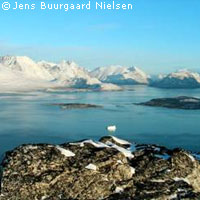Study highlights contribution of glaciers and ice caps to sea level rise
Melting glaciers and ice caps will contribute more to sea level rise this century than the Greenland and Antarctic ice sheets, according to new research. The study, which is published online by the journal Science, was partly funded by a Marie Curie grant from the EU. The scientists state that around 60% of the ice which is being lost to the oceans and contributing to sea level rise comes from glaciers and ice caps. In contrast, Greenland's ice sheet is contributing 28% of the ice with the remaining 12% coming from the Antarctic. 'While large ice masses may surpass the glacier contribution to sea level rise in the distant future, the GIC [glaciers and ice caps] contribution is important now and will be for the remainder of this century,' the paper states. The international team of scientists arrived at its conclusions after studying satellite, aircraft and ground-based data from glaciers and ice caps around the world, as well as from the Greenland and Antarctic ice sheets. 'One reason for this study is the widely held view that the Greenland and Antarctic ice sheets will be the principal causes of sea-level rise,' said Professor Mark Meier of the University of Colorado, who led the study. 'But we show that it is the glaciers and ice caps, not the two large ice sheets, that will be the big players in sea rise for at least the next few generations.' Furthermore, the rate of ice loss from glaciers is speeding up, due to an acceleration in the flow of glaciers that discharge icebergs directly into the ocean. When these tidewater glaciers become thinner, a larger fraction of their weight is supported by water, causing them to slide along their beds faster. 'While this is a dynamic, complex process and does not seem to be a direct result of climate warming, it is likely that climate acts as a trigger to set off this dramatic response,' explained Professor Robert Anderson of the University of Colorado. The scientists estimate that this accelerated glacier melt will cause the sea level to rise by an additional 0.1 to 0.25 metres by 2100. 'At the very least, our projections indicate that future sea level rise may be larger than anticipated, and that the component due to GIC will continue to be substantial,' they write. Meanwhile the scientists note that it is important to monitor as many glaciers as possible. 'Since the world is becoming increasingly aware that sea level rise is a very real problem, we need to acknowledge the role of all of the ice masses and understand the physical mechanisms by which they deliver water to the sea,' commented Professor Anderson.



